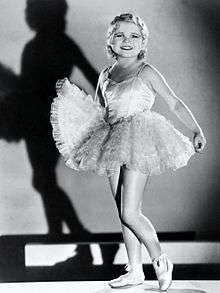Daisy Earles
| Daisy Earles | |
|---|---|
 Earles in a scene from the film Freaks, 1932 | |
| Born |
Hilda Emma Schneider November 15, 1899 Stolpen, Germany |
| Died |
December 15, 1981 (aged 82) Sarasota, Florida, United States |
| Occupation | tiny artists in Hollywood films and circus |
| Years active | 1920–1958 |
| Known for | Films Freaks and The Wizard of Oz |
| Height | 39 in (99 cm) |
| Relatives |
Tiny Earles (sister) Gracie Earles (sister) Harry Earles (brother) |
Daisy Earles (1899-1981) was a German dwarf who migrated to the United States in the early 1920s. She worked in Hollywood films in California and later toured with circus companies. Daisy Earles was blonde, pretty, and tall compared to her other sisters, and had a very well proportioned figure, for which she earned the epithet of a "miniature Mae West". Her circus acts with her siblings were as "parade performers".
Biography
Daisy Earles was born Hilda Emma Schneider on April 29, 1907 in Stolpen, Germany.[1] Her parents were Emma and Gustav Schneider. Their three daughters, less than average height, migrated to the United States. They were encouraged by their father to work in the entertainment field taking advantage of their "hypopituitary" midget status. [2][3][4] Daisy's brother Kurt and sister Frieda were the first to migrate to California in 1916 after they had met Bert W. Earles and his wife, who became their agents. The Earles had toured with the Dancing Dolls family prior to their joining films and acting with new names. Kurt and Frieda changed their names to Harry and Grace to act in films and they adopted the surname "Earles" of their manager. Their first dance appearance was for the Buffalo Bill Show in the roles as "Hansel and Gretel" for which they were hailed as the "Smallest Dancing Couple in the World”. Hilda, who later came to be known as Daisy Earles, joined her brother and sister in California in the early 1920s. Another sister, Elly, joined them in 1926; she was called "Tiny", because of her appearance. All four siblings, who had earlier taken the surname Earles, changed it to "Doll" after the death of their manager, Earles.[4][5][6] [5][2][6]
Daisy Earles' was most well known for her part in "Freaks" in 1932. However, the film was considered horrifying and was shown in the U.S. with many cuts, banned in England, and in Canada was called "brutal and grotesque". [7][1][4][8]
In 1928, Earles had appeared in the 1928 film Three-Ring Marriage.[1]. She and her siblings Tiny, Grace, and Harry, performed as "Munchkins" in a song and dance sequence along the Yellow Brick Road, in The Wizard of Oz (1939). They were not credited individually in the film, but as "The Singer Midgets, despite having been generally well-known as "The Doll Family".[2][3] She had a small uncredited role in 1952's The Greatest Show on Earth, for which she won an award for her "blink-and-you-miss-it" photo shot.
Daisy retired from film acting in 1952, after her bit part in The Greatest Show on Earth.[7] She and her siblings continued working for the Ringling Brothers Circus and Barnum and Bailey Circus where they appeared as "parade performers" in "side shows for 30 seasons". They all retired in 1958.[2][4][9]
Following retirement, Daisy lived in Sarasota, Florida with her three siblings.[4] Subsequent to Daisy's death in December 1981 at the age of 82, three documentaries dedicated to her and her siblings were released. These are: Freaks Uncensored! (1999), Ce nain que je ne saurais voir! (2015, a TV film), and Schlitzie: One of Us (2015).[1] In one , it is stated that Franz Taibosh, an Afrikaner, had a "crush" on her, but she was not interested as she was already married to her husband. He also worked as a chauffeur and security person for her family.[10]
References
- 1 2 3 4 "Daisy Earles (1907–1980)". Internet Movie Data base(OMDb). Retrieved 2 June 2016.
- 1 2 3 4 Senn 2006, p. 65.
- 1 2 Kérchy & Zittlau 2013, p. 272.
- 1 2 3 4 5 "Tiny Doll". The Daily Telegraph. 15 September 2004. Retrieved 14 June 2016.
- 1 2 Parsons & Smith 2010, p. 112.
- 1 2 Eagan 2010, p. 190.
- 1 2 Paszylk 2009, p. 28.
- ↑ "Daisy Earles". Turner Classic Movies. Retrieved 2 June 2016.
- ↑ "Daisy Earles Biography". setcelebs.com. Retrieved 2 June 2016.
- ↑ Parsons & Smith 2010, p. 128.
Bibliography
- Eagan, Daniel (2010). America's Film Legacy: The Authoritative Guide to the Landmark Movies in the National Film Registry. A&C Black. ISBN 978-0-8264-2977-3.
- Kérchy, Anna; Zittlau, Andrea (2013). Exploring the Cultural History of Continental European Freak Shows and ‘Enfreakment’. Cambridge Scholars Publishing. ISBN 978-1-4438-4642-4.
- Parsons, Neil; Smith, Alexander McCall (2010). Clicko: The Wild Dancing Bushman. University of Chicago Press. ISBN 978-0-226-64742-5.
- Paszylk, Barthomiej (2009). The Pleasure and Pain of Cult Horror Films: An Historical Survey. McFarland. ISBN 978-0-7864-5327-6.
- Senn, Bryan (2006). Golden Horrors: An Illustrated Critical Filmography of Terror Cinema, 1931–1939. McFarland. ISBN 978-0-7864-2724-6.